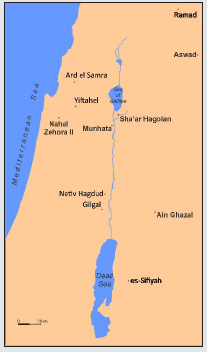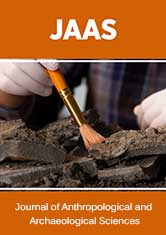
Lupine Publishers Group
Lupine Publishers
Menu
ISSN: 2690-5752
Review Article(ISSN: 2690-5752) 
Investigating Hybridity: Neolithic Human-Bird Figurines from the Southern Levant Volume 5 - Issue 4
Estelle Orrelle1 and Liora Kolska Horwitz2*
- 1Independent Scholar, University of East London, UK
- 2National Natural History Collections, The Hebrew University of Jerusalem, Israel
Received:September 27, 2021 Published: October 21, 2021
Corresponding author: Liora Kolska Horwitz, National Natural History Collections, The Hebrew University of Jerusalem, Israel
DOI: 10.32474/JAAS.2021.05.000216
Abstract
In this paper, we explore ceramic figurines depicting human-bird therianthropes, from Neolithic sites in the Southern Levant. We argue that the choice of birds was not accidental as, aside from their attractive physical characteristics (e.g. ability to fly), they represented a class of animals that was still wild in a period that witnessed the domestication of many other taxa. These hybrid images reflect the “transfer” of animal properties to humans - the birds vital force, physical and spiritual attributes – thus, enabling assimilation of their extra-ordinary powers. We suggest that these figurines are part of a wider ontology created by Neolithic communities in this region which bound them to birds, especially raptors.
Keywords: Avian Images; Therianthropes; Neolithic Iconography; Hybrid Images
Introduction
Human–animal hybrids (therianthropes) appear worldwide and throughout human history in literature, iconography and religious beliefs, reflecting the widespread fascination with the topic [1-2]. They are of particular interest as they clearly do not represent ‘reality’ but a symbolic or perceived reality in which the separate categories of human and animal, have been collapsed. Like all symbolic representations, they offer a key to understanding beliefs, behaviors and institutions since their creation is a social act [3-7], although they can be difficult to deconstruct since representation entails reconfiguration and interpretation of reality, rather than its faithful reproduction. In recent years, researchers such as Bruno Latour [8] have proposed that animals (like all “non-humans”), should be subject to the same (he uses the term “symmetrical”) treatment as humans and so puts an end to our objectification of them. In other words, humans and animals are ontologically inseparable. Instead of animals being objectified and so defined solely by an anthropocentric perspective, they are defined through their mutual relations with humans [9]. Indeed, for Latour, animals only have agency if they become “hybrid” or are taken into a hybrid (‘nature culture’) network, in other words as long as they are in contact, directly or not, with humans. This tallies well with ethnographic accounts of animistic hunter-gatherers [10,11] which emphasize that these communities feel a very close affinity between themselves and the natural world, with animals perceived as being in an alliance with humans. As stated by Bradley [12] “The very idea that humans and animals are different in kind may be alien to their way of thinking”. Thus, in such traditional societies, therianthropic images are perceived as manifestations of this sense of relatedness, just as some traditional communities believe that humans (especially shamans) and animals can easily transform themselves (shape shift) into each other [13-15].
This view gives rise to the central issue addressed in this paper - if embracing human-animal hybridity is an integral part of the worldview of many hunter-gatherer communities, why then are such hybrid images still widespread in Neolithic communities in the Levant, societies that represent the earliest sedentary agro- pastoralists? This is especially surprising, since Neolithic humans were the first to gain domination over animals through their domestication [16]. The act and consequence of domestication would have significantly shifted peoples’ ‘egalitarian’ views of nature. With reference to a corpus of Neolithic human-bird hybrid figures from sites in the Southern Levant (Figure 1), we propose that the appearance of this specific form of iconography was not accidental. It was a ‘relic’ of the earlier ‘natureculture’ network that enmeshed humans and wild animals. While several animal taxa underwent domestication during the Neolithic, so breaking this bond, birds and especially raptors, were given a special, elevated status [17-19]. Thus, Neolithic communities created a unique ontology which bound them with birds/raptors. By merging these two entities in a hybrid image (a good example of Latour’s ‘natureculture’ network), the two were given equal status. This transformed, spiritualized and empowered the human body with bird/raptor-like qualities.
The Finds
Pre-Pottery Neolithic A (PPNA; ~11,500–10,500 cal BP)
Numerous examples of bird therianthopic ceramic figurines first appear in this period and can be identified in what Garfinkel [20] termed ‘cylindrical’ or ‘pillar’ figurines. Their bird-like attributes were first recognised by de Conteson [21-24]. He termed them ‘pions’ (i.e., chess pawns), describing them as elliptical or conical-shaped figurines (tube-like), with a head shaped to form a point and a pinched nasal area. de Contenson [22,24] and noted their “beaklike noses” and “butterfly wing arms” in their profile view. Wengrow [25] pointed out that these figurines include complex but relatively standardized forms made by “adding body parts to a central stalk, with features created by carving, painting or application”. Their erect posture and free-standing vertical posture on a flat base signify bipedalism and therefore, anthropomorphism. Bifurcations are found at the base of some figurines, perhaps denoting legs. Many are bent forward implying movement, which would further support this idea [18-24]. Indeed, Hershman and Belfer-Cohen [26] have emphasized the anthropocentrism of these images and described them as generic human proto-types.
We propose that, the use of an elliptical free-standing core was a device specifically employed to unite elements of human and animal form, since their duality is revealed only when observing both frontal and profile views. Particularly, Stordeur et al. [27] have pointed out the interplay between the human-like frontal view and the avian aspect of the profile - revealing arms/wing and the head/ beak of a bird. While many of these ‘pillar’ figurines are missing heads (i.e., broken off accidentally), other features on the torso such as presence of wings, depiction of plumage by incisions or indentations, or their forward stance, all serve to identify them as human-bird hybrids. We present some examples of such hybrids in Figure 2. Pillar figurines are described from the PPNA site of Gilgal I [28- 30]. As illustrated in Figure 2a, the frontal view of one of these elliptical clay items suggests a bird with a beak, with a square or a fan-shaped head. The body bears a vertical column of lunateshaped incisions in sets of three, interpreted as indicating feathers [26]. Yizraeli-Noy [30] calls this object a magic artifact. Another figurine from the site of Gilgal 1, shown in Figure 2b, was described by Yizraeli-Noy [30] as “cylinder shaped with diagonal head and bird-like eyes.” A very schematic limestone, pawn-like item from Gilgal III shown in Figure 2c, includes a number of characteristics we attribute to a human-bird hybrid [29]. Diagonal lines running parallel along the front hint at wings in profile. The upward pointing apex of the head is bird-like, the figurine leans to one side, and its entire surface is incised with shallow vertical striations suggestive of feathers. The ‘head’ at the top of the long neck of an item from the PPNA of Netiv Hagdud (Figure 2d) is fan-shaped with widely-spaced, bird-like eyes and short ‘wing-like’ stumps for arms. Fragments of the same figurine type (Figure 2e) from this site, have remains of breasts and an incised net pattern on the top of the head.
Figure 2: Examples of Pre-Pottery Neolithic A ceramic human-bird hybrid figurines (source references and dimensions in mm are given). a. Gilgal I [30 on page 32, Fig. 9; size 70x26]; b. Gilgal I [30, Fig. 10, size 37x12]; c. Gilgal III [29, Fig. 11.13, Plate on pg. 203]; d. Netiv Hagdud [31, Fig. 6-1-2:1, size 47x23x22]; e. Netiv Hagdud [31, Fig. 6-1-2:1, size 56x22x12].
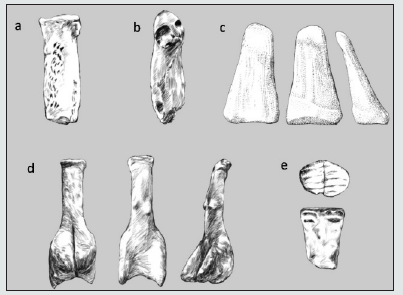
Pre-Pottery Neolithic B (PPNB; ~10,500-8,250 cal BP)
Figure 3: Examples of Pre-Pottery Neolithic B ceramic human-bird hybrid figurines (source references and dimensions in mm are given). a. Munhata [20, Fig 13.1, size 15x22x57]; b. Munhata [20, Fig 13.6, size 36x21x12]); c. Munhata [20, Fig. 14:6, size 16x25x49]; d. Munhata [20, Fig 14.7, size 17x28x44]; e. Ain Ghazal [34, Fig.14.6, no. 39, size 43x19]; f. es-Sifiya [35, on page 117, Fig. 4 No 3, and Plate 23Z, size 39x19x26]; g. f. es-Sifiya [35, on page 117, Fig. 4 No 1, and Plate 23Z, size 31x23x23].
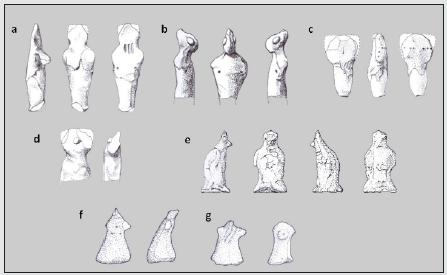
Some of the PPNB examples of human-bird hybrids are highly schematic, small and standardized. In most figurines, the taxonomic ambiguity is evident when the different frontal and profile images are combined. These different aspects are used to express humanbird hybridization and also dual genders. In the PPNB layers at Tell Aswad, Ayobi [32] reported isolated examples of what she called ‘ambiguous’ human/animal types’ and noted their similarities with the hybrid Neolithic bird-woman examples from Eastern Europe described by Gimbutas [33] A number of pion or pillar type figurines were also identified at this site [32]. In the PPNB layers at the site of Munhata (Figure 3a), Garfinkel [20] described a series of pillar figurines and interpreted them as representing females due to the presence of breasts. However, the fan or squareshaped heads of four of the figurines [20], and profiles of five of them [20] are suggestive of birds, which in our opinion makes them woman-bird hybrids. Cord-like impressions on the breast of one of the figurines [20] resemble feathers/plumage. In Figure 3b, the bird-like head is visible both frontally and in profile. Another group of highly schematic figurines from PPNB Munhata were classified by Garfinkel [20] as anthropomorphic “genderless” or “conical” types (Figure 3c). These figurines have fan/square heads (Figure 3d) and on one of them [20], there are cord-like incisions on the body, suggesting feathers. Figure 3e, from the PPNB of ‘Ain Ghazal, was described by Schmandt-Besserat [34] as a complete standing figure bending forward with a pointed face/muzzle. We suggest it represents a hybrid woman-bird image based on the sharp features of the face which resemble a beak in profile. The features on each side of the chest may be arms or folded wings. The semi-circular base is pinched on either side to depict feet. Schmandt-Besserat [34] has pointed out that there is inter-site variation in the shape of the conical figurines. For example, in some figurines from the site of Gwair I, the top of the cone is bent over and covered with fine punctate impressions [36] illustrating, as we suggest, plumage. Figurines with a schematic head created by pinching a cone tip, are found at the sites of Ramad [23] and at Munhata [20]. They are also one of the seven classes of figurines listed for the site of es-Sifiya [35]. At this site, figurines (Figures 3f-g), with a stylized conical shaped body have protuberances for arms and the head/neck is indicated by a crest perpendicular to the arms.
Pottery Neolithic (PN; ~8250-6800 cal BP)
Figure 4: Examples of Pottery Neolithic ceramic human-bird hybrid figurines (source references and dimensions in mm are given). a. Yiftahel [38, Fig.19.1, size 40x17]; b. Ard el-Samra [39, Fig. 11, size 11x39]; c. Munhata [20, Fig. 38.3, size 37x23x18]; d. Munhata [20, Fig. 38.5l, size 24x12x11].
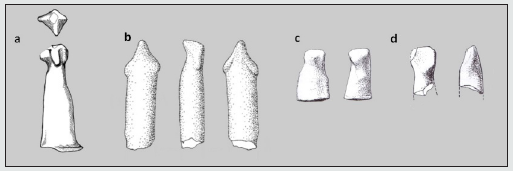
Relatively few human-bird hybrid figurines have been identified in PN assemblages. Sites such as Munhata [20] and Sha’ar Hagolan [37] feature pillar figurines with hybrid human-bird features such as small upper conical ends with a pointed top. In addition, a figurine (Figure 4a) from the PN layer at Yiftahel may belong to this class although Commenge [38] thought that it was “not suggestive enough to assert that an anthropomorphic representation was intended”. A figurine of the same type, with a triangular head and a pointed nose like a bird’s beak, was reported from the PN (Wadi Rabah) deposits at Ard el-Samra [39] (Figure 4b). Rollefson et al. [40] identified a similar styled figurine in a Yarmoukian context at ‘Ain Ghazal and also thought it was bird-like. In the Wadi Rabah stratum at ‘Ain Ghazal, a cylindrical figurine [34] has striations on its body, in our view suggestive of feathers, and widely spaced eyes (bird-like?) but is described by Schmandt-Besserat as a figurine with a phallic head rather than as a bird hybrid. At Nahal Zehora ll, most of the incised stone items bear incisions and striations, that may denote feathers. Several fragments (Figures 4c-d) of highly schematic figurines were discovered at Munhata in the Wadi Rabah layer and were classified by Garfinkel [20] as miscellaneous baked clay items. We suggest that, although highly schematic, birds’ heads can be discerned on these figurines. In addition, ceramic anthropomorphic figurines from Nahal Zehora II are depicted with only three or even four fingers at the ends of their limbs, which is more of an avian than human characteristic [41]. For example, a Yarmukian anthropomorphic figurine has three fingers [41], while the fragment of an arm and hand has four fingers [41]. Another group of schematic figurines bear incised lines and striations (i.e., feathers) and were termed incised trapezoids [41]. These figurines are shaped like a rectangle with a narrow apex and broader base [41], which following Gimbutas [33], may represent a highly schematic representation of an egg. It is suggested here that they too may represent very schematic bird therianthropes.
Discussion
Most studies addressing zoomorphic iconography in the Southern Levant have highlighted the importance of correctly identifying the animal species depicted. This pursuit for anatomical accuracy has perhaps led to a neglect of that very small part of the record that is ambiguous, counter-intuitive, and mixed. In this study we have documented a diachronic series of such ambiguous figurines that in our view depict human-bird hybrids. This imagery is probably first observed in the Southern Levant in the Natufian period (~15,000-11,500 cal BP), where we have identified two possible examples from the site of Nahal Oren. As discussed here, human-bird hybrids are well-established in the subsequent Pre- Pottery Neolithic of the Southern Levant. They are also documented in the Northern Levant and Anatolia at this time [43-45] and may reflect a shared symbolic world while leaving room for localized expressions of this same cultural vocabulary. The Neolithic hybrid figurines entailed careful selection of features, often including the gender of the anthropomorph and the manner in which hybridization was represented. Our perception of these items converges with those proposed by Wengrow [25], in the context of Predynastic Egyptian hybrid images, that new, meaningful relations emerge from the blending of affinities. Thus, it is possible to identify key physical human and avian features, or a combination of one or more of them, that characterize these hybrid figurines.
Human features
a) These are represented in the elliptical shape of the figurine, occasional presence of a bifurcation at the base of the pillar implying legs, presence of genitalia and frequently, the presence of a well-defined head with human facial attributeseyes, nose, eyebrows, ears etc.
b) The hybrids are both female as attested by presence of breasts and protruding buttocks, or male as attested by the presence of genitalia, while the overall cylindrical shape of the pillar figurines can also be interpreted as phallus-like.
c) The forward bending stance and bifurcations near the base observed in many of the figurines evoke bipedalism.
Avian features
a. These include beak-like noses, arched eyebrows, widely spaced eyes and two, three or four toes/fingers. The tridactylous and the tetradactylous hands are features identified with a birdgoddess [46]. The arched eyebrows and beak or nose, that are usually connected with the brow-ridges in the shape of an anchor or letter T, also contribute to the bird-like character of these depictions [33].
b. Protuberances on the upper part of the torso which represent stumps or stubby arms as well as bent or v-shaped arms on various figurine types. An iconography of wing imagery seems to be incorporated in the position of the arms in these figurines. In the Neolithic period they all seem to be closed or drooping.
c. Plumage may be depicted in a variety of incised forms-a net pattern, V-shaped lines, punctuates, longitudinal striations etc. but their location on the body of the figurine conforms to feathered areas on a bird.
d. An upward pointing or forward-leaning posture as well as a head and nose/beak pointing upwards which create a point when seen in profile. The upward pointing head posture is termed “bill tilt” “head up” or “head up threat” and is observed in some bird species when engaged in courting behavior, where males compete for dominance, and vie for the attention of females [47].
e. Features that depict, or are suggestive of, eggs or eggcarrying [33] such as a protruding buttock, and in its a more schematic form represented as a broad base or widened lower register on a figurine. Notably, in some Neolithic sites (e.g., Tel Ramad in southern Syria and Tel Sabi Abyad in northern Syria), alongside human remains, ritualized egg-shaped clay objects were found, whose smooth, rounded external form evokes that of human crania as well as eggs [48]. Diachronic changes in their depiction are also observed over the course of the Neolithic, from iconic to the schematic. In the earlier PPNA, these human-bird figurines encompass a variety of types, but most are of the pion type – incorporating well defined, easily recognizable human and avian features. In the later PPNB and PN, the pion figurines are joined by more schematic and abstract examples which are characterized by simplicity of form. This implies that by this time the bird-human hybrid image was so well established that its reduction to a “shorthand version” sufficed. Although the precise function of these figurines remains enigmatic, the hybrid images were clearly symbols that signified concepts beyond themselves that are allegorical or symbolic. We contend that the Neolithic bird therianthropes demonstrate the continuation of an earlier hunter-gatherer ontology, one that did not separate human culture and society from other natural beings but enjoyed an affinity with nature and wild animals. Since birds were not undergoing domestication at this time, Neolithic peoples could be ‘equal’ and so could be merged, sharing their source of power, spiritual qualities and well as physical traits (wings, feathers, beaks merged with legs, thorax etc.).
Symbolically, the human-bird hybrid was designed to portray divine or supernatural qualities and so hybrids were a symbolic means for humans to acquire extra-ordinary avian qualities, such as the ability to fly and leave earth, a feature of shamanic out-ofbody quests. The acquisition of such ‘superhuman’ qualities may have been especially attractive to people living through a period of dramatic socio-economic change, characterized by their increasing dominion (via domestication) over many other life forms, both plants and animals. This tallies with Gimbutas [33] claims, that the primary purpose of hybrids was to transform and spiritualize the body. At the same time, the process of hybridization imbued the birds with anthropogenic qualities-literally bringing them down to earth-and so making them an integral part of the human world.
Conclusion
In conclusion, we evoke Boyer’s ideas [49,50] and suggest that the intention of the therianthropes studied here was not to show anatomically accurate humans or animals but to intentionally depict counter-intuitive beings which violate natural cognitive expectations. Consequently, by intentionally breaking the constraints of taxonomy, depictions of hybridity in the Neolithic served as powerful devices intended to convey and express symbolically loaded ideas.
References
- Eliade M (1965) Rites and Symbols of Initiation: The Mysteries of Birth and Rebirth. New York: Harper & Row.
- Russell N (2012) Social Zooarchaeology: Humans and Animals in Prehistory. Cambridge University Press, Cambridge, USA.
- Bailey D W (1994) Reading prehistoric figurines as individuals. World Archaeology 25(3): 321-331.
- Chaplin E (1994) Sociology and Visual Representation. Routledge, London UK.
- Koloski Ostrow A O, Lyons C L eds (2004) Naked Truths. Women, Sexuality, and Gender in Classical Art and Archaeology. Routledge, UK.
- Moser S (2001) Archaeological representation: the visual conventions for constructing knowledge about the past. In Hodder I ed. Archaeological Theory Today. Cambridge: Polity Press pp. 262-283.
- Stanczak G C ed (2007) Visual Research Methods: Image, Society, and Representation. Sage Publications, London, UK.
- Latour B (1993) We Have Never been Modern. Cambridge Mass, Harvard University Press, USA.
- Watts C (2013) Relational Archaeologies: Humans, Animals, Things. Routledge, London, UK.
- Bird David N (1999) “Animis” revisited: personhood, environment, and relational epistemology. Current Anthropology 40 (S1): S67-S91.
- Ingold T (2000) The Perception of the Environment. Essays on Livelihood, Dwelling and Skill. Routledge, London and New York, UK and USA.
- Bradley R (2001) Humans, animals and the domestication of visual images. Cambridge Archaeological Journal 11(2): 261-263.
- Viveiros de Castro E (1998) Cosmological deixis and Amerindian perspectivism. Journal of the Royal Anthropological Institute 4(3): 469-88.
- Aldhouse Green M, Aldhouse Green S (2005) The Quest for the Shaman: Shape-Shifters, Sorcerers and Spirit Healers in Ancient Europe. Thames & Hudson, London, UK.
- Saniotis A (2019) Becoming animals: neurobiology of shamanic shapeshifting. Neuro Quantology 17(5): 81-86.
- Gourichon L, Horwitz L K (2021) An inter-regional comparison of animal domestication in the Northern and Southern Levant. Food & History 19(1-2): 53-78.
- Dobney K (2002) Flying a kite at the end of the Ice Age: The possible significance of raptor remains from proto-and early Neolithic sites of the Middle East. Buitenhuis H, Choyke A, Mashkour M, Al-Shiyab A (Eds.), Archaeozoology of the Near East V: 74-84. Groningen: ARC Publications.
- Gourichon L (2002) Bird remains from Jerf el Ahmar, a PPNA site in northern Syria, with special reference to the Griffon Vulture (Gyps fulvus). Buitenhuis H, Choyke A, Mashkour M, Al-Shiyab A (Eds.), Archaeozoology of the Near East V: 138-152. Groningen, ARC Publications.
- Birkenfeld M, Avner U, Bar Yosef Mayer D, Cummings L S, Natalio F et al (2020) Dating, archaeology and paleoenvironment of the Late Pre-Pottery Neolithic B site of Naḥal Roded 110, in the Eilat Mountains. Paléorient 46(1-2): 43-68.
- Garfinkel Y (1995) Human and Animal Figurines of Munhata (Israel). Les Cahiers des Missions Archeologiques Francaises en Israel 8, Association Paléorient, Paris.
- De Contenson H (1981) L'art du Neolithique preceramique en Syrie-Palestine. Bolletino del Centro Communo di Studi Preistorico 18: 53-64.
- De Contenson H (1985) Le materiel des tels archaeologiques. In Sanlaville P ed. Holocene Settlement in North-Syria: 99-161, 67-178. BAR International Series 238. Oxford: British Archaeological Reports.
- De Contenson H (1995) Aswad et Ghoraife sites Neolithique en Damascene (Syrie) aux IXe et Vllle millenaire avant l'ere Chretienne. Beyrouth: B.A.H.
- De Contenson H (2000) Ramad Site Neolithique en Damascene (Syrie) aux VIIIe et VIIe Millenaires avant l'ere Chretiennne. Beirut: Institut Francais d'Archaeologie de Proche Orient, Bibliotheque Archeologique et Histoire Tome 157.
- Wengrow D (2014) The Origin of Monsters Image and Cognition in the First Age of Mechanical Reproduction. Princeton: Princeton University Press.
- Hershman D, Belfer Cohen A (2010) "It's Magic!": Artistic and symbolic material manifestations from the Gilgal sites. In Bar Yosef O, Goring Morris A.N, Gopher A eds. Gilgal Early Neolithic Occupations in the Lower Jordan Valley: The Excavations of Tamar Noy. Oxford, Oxbow Books pp. 185-216.
- Stordeur D, Jammous B, Khawam R, Morero E (2006) L’aire funéraire de Tell Aswad (PPNB). Syria 83: 39-62.
- Noy T (1989) Gilgal I-A Pre-Pottery Neolithic site in Israel: the 1985-1987 seasons. Paléorient 15(1): 11-18.
- Bar Yosef O, Goring Morris N, Gopher A (2010) Gilgal Early Neolithic Occupation in the Lower Jordan Valley. Oxbow Books, Oxford, USA.
- Yizraeli Noy T (1999) The Human Figure in Prehistoric Art in the Land of Israel. Jerusalem: Israel Museum Publications, Hebrew, Israel.
- Bar Yosef O, Gopher A eds (1997) An Early Neolithic Village in the Jordan Valley - Part I: The Archaeology of Netiv Hagdud. American School of Prehistoric Research Bulletin 43. Harvard University, Peabody Museum of Archaeology and Ethnology, USA.
- Ayobi R (2013) Humaines ou animales? Des figurines ambiguës à Tell Aswad. ArchéOrient-Le Blog.
- Gimbutas M (1974) Goddesses and Gods of Old Europe. Thames and Hudson, London, UK.
- Schmandt Besserat D (2013) Symbols at 'Ain Ghazal. ‘Ain Ghazal Excavation Reports 3: 113-65.
- Mahasneh H, Bienert H D (1999) Anthropomorphic figurines from the early Neolithic site of eṣ-Ṣifīye (Jordan). Zeitschrift des Deutschen Palästina-Vereins 115 (2): 109-126.
- Najjar M (2002) Symbolism in the imagery of the early Neolithic of Wadi Faynan, Jordan. Gebel H G K, Hermansen B D, Jensen C H (Eds.), Magic Practices and Ritual in the Near Eastern Neolithic. Studies in Early Near Eastern Production, Subsistence and Environment. Berlin: exoriente 8: 103-108.
- Garfinkel Y, Ben Shlomo D, Korn N eds (2010) Shaar Hagolan Vol. 3. Symbolic Dimensions of the Yarmukian Culture: Canoization in Neolithic Art. Jerusalem, Israel Exploration Society, Israel.
- Commenge C (1997) A pottery figurine from Yiftahel. Braun E (Eds.), Yiftah’el: Salvage and Rescue Excavations at a Prehistoric Village in Lower Galilee Israel. Israel Antiquities Authority Reports 2. Jerusalem, Israel Antiquities pp. 180-181.
- Barzilai O (2010) Ard el-Samra. Hadashot Arkheologiyot (Excavations and Surveys in Israel) pp. 122.
- Rollefson G O, Zeidan A. Kafafi Z A, Simmons A H (1991) The Neolithic village of 'Ain Gh̊azal, Jordan: preliminary report on the 1988 season. Bulletin of the American Schools of Oriental Research 27: 95-116.
- Gopher A, Eyal R (2012) Nahal Zehora pottery assemblages: typology. In Gopher A ed. Village Communities of the Pottery Neolithic Period in the Menashe Hills, Israel. Archaeological Investigations at the Sites of Nahal Zehora, Monograph Series. Sonia and Marco Nadler Institute of Archaeology, Tel Aviv University 29: 359-523.
- Noy T (1991) Art and decoration of the Natufian at Nahal Oren. In Bar-Yosef O, Valla F eds. The Natufian Culture in the Levant. Ann Arbor: International Monograph in Prehistory pp. 557-568.
- Boric D (2007) Images of animality: hybrid bodies and mimesis in early prehistoric art. In Renfrew C, Morley I eds. Image and Imagination. A Global Prehistory of Figurative Representation. McDonald Institute for Archaeological Research, Cambridge, USA p. 83-105.
- Hodder I, Meskell L (2010) The symbolism of Catalhoyuk in its regional context. In Hodder I ed. Religion in the Emergence of Civilization: Catalhoyuk as a Case Study. Cambridge University Press, Cambridge, USA p. 32-72.
- Dönmez S (2018) Hybrid beings and representation of power in the prehistoric period. Tarih Araştırmaları Dergisi 37(64): 97-124.
- Golan A (1991) A Myth and Symbol. Schoen Books, Jerusalem.
- Stokes P W, Stokes L Q (2003) Backyard Bird Book: The Complete Guide to Attracting, Identifying and Understanding the Birds in your Backyard. Rodale Press, Pennsylvania, USA.
- Verhoeven M (2000) The excavations: stratigraphy and architecture. Verhoeven M, Akkermans PMMG (Eds.), Tell Sabi Abyad II: The Pre-Pottery Neolithic B Settlement. Report on the Excavations of the National Museum of Antiquities Leiden in the Balikh Valley, Syria: 3–49.
- Boyer P (1996) What makes anthropomorphism natural: intuitive ontology and cultural representation. Journal of the Anthropological Institute 2: 83-97.
- Boyer P (2001) Religion Explained: The Evolutionary Origins of Religious Thought. Basic Books, New York, USA.

Top Editors
-

Mark E Smith
Bio chemistry
University of Texas Medical Branch, USA -

Lawrence A Presley
Department of Criminal Justice
Liberty University, USA -

Thomas W Miller
Department of Psychiatry
University of Kentucky, USA -

Gjumrakch Aliev
Department of Medicine
Gally International Biomedical Research & Consulting LLC, USA -

Christopher Bryant
Department of Urbanisation and Agricultural
Montreal university, USA -

Robert William Frare
Oral & Maxillofacial Pathology
New York University, USA -

Rudolph Modesto Navari
Gastroenterology and Hepatology
University of Alabama, UK -

Andrew Hague
Department of Medicine
Universities of Bradford, UK -

George Gregory Buttigieg
Maltese College of Obstetrics and Gynaecology, Europe -

Chen-Hsiung Yeh
Oncology
Circulogene Theranostics, England -
.png)
Emilio Bucio-Carrillo
Radiation Chemistry
National University of Mexico, USA -
.jpg)
Casey J Grenier
Analytical Chemistry
Wentworth Institute of Technology, USA -
Hany Atalah
Minimally Invasive Surgery
Mercer University school of Medicine, USA -

Abu-Hussein Muhamad
Pediatric Dentistry
University of Athens , Greece

The annual scholar awards from Lupine Publishers honor a selected number Read More...




